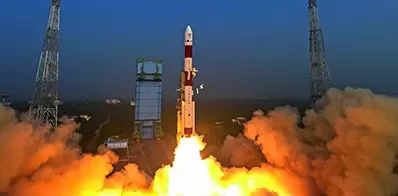SRIHARIKOTA: Isro ushered in the New Year with the successful launch of XPoSat (X-ray Polarimeter Satellite), India’s first satellite to conduct research on black holes and other celestial objects.
Workhorse PSLV placed the satellite on its 60th flight in a 650km orbit. The final stage of PSLV-C58 then turned into an orbital experimental module (POEM) to test the 10 payloads over the next month.
Around 22 minutes after the lift-off from Satish Dhawan Space Centre in Sriharikota, the rocket injected XPoSat. The rocket went through at least two coasting phases — when the engines were not fired — to place the satellite with a 6-degree inclination.XPoSat will carry out studies of X-rays emitted by celestial objects like black holes, neutron stars and galactic nuclei. It carries two payloads — Polix (Polarimeter Instrument in X-rays) by Raman Research Institute and Xspect (X-ray spectroscopy and timing) by Space Astronomy Group of URSC.
PM Narendra Modi hailed the launch. “A great start to 2024 thanks to our scientists! This launch is wonderful news for the space sector and will enhance India’s prowess in this field. Best wishes to our scientists at @isro and the entire space fraternity in taking India to unprecedented heights,” Modi tweeted.
Isro chairman S Somanath described the launch as a “New Year gift to all of us”. “The satellite is unique. It complements the scientific objective we have set for various observations of the universe. It goes with Astrosat and Aditya-L1,” Somanath said.
Workhorse PSLV placed the satellite on its 60th flight in a 650km orbit. The final stage of PSLV-C58 then turned into an orbital experimental module (POEM) to test the 10 payloads over the next month.
Around 22 minutes after the lift-off from Satish Dhawan Space Centre in Sriharikota, the rocket injected XPoSat. The rocket went through at least two coasting phases — when the engines were not fired — to place the satellite with a 6-degree inclination.XPoSat will carry out studies of X-rays emitted by celestial objects like black holes, neutron stars and galactic nuclei. It carries two payloads — Polix (Polarimeter Instrument in X-rays) by Raman Research Institute and Xspect (X-ray spectroscopy and timing) by Space Astronomy Group of URSC.
PM Narendra Modi hailed the launch. “A great start to 2024 thanks to our scientists! This launch is wonderful news for the space sector and will enhance India’s prowess in this field. Best wishes to our scientists at @isro and the entire space fraternity in taking India to unprecedented heights,” Modi tweeted.
Isro chairman S Somanath described the launch as a “New Year gift to all of us”. “The satellite is unique. It complements the scientific objective we have set for various observations of the universe. It goes with Astrosat and Aditya-L1,” Somanath said.
A Raman Research Institute release said XPoSat is only the second x-ray polarimetry mission in the world, after Nasa’s Imaging X-ray Polarimetry Explorer (IXPE) launched in 2021. The 10 payloads in the PS4 orbital module include fuel cell power system and Silicon-based high energy cell from Vikram Sarabhai Space Centre, Isro.
On missions planned this year, Somanath called 2024 as the year of Gaganyaan readiness and said the agency targets at least 12-14 missions this year. .
Meanwhile, Aditya-L1, the spacecraft for India’s maiden solar mission, would reach its final destination — the L1 point of the Sun — on January 6 when a final manoeuvre would be performed, Isro chief S Somanath said.
Denial of responsibility! Swift Telecast is an automatic aggregator of the all world’s media. In each content, the hyperlink to the primary source is specified. All trademarks belong to their rightful owners, all materials to their authors. If you are the owner of the content and do not want us to publish your materials, please contact us by email – swifttelecast.com. The content will be deleted within 24 hours.


